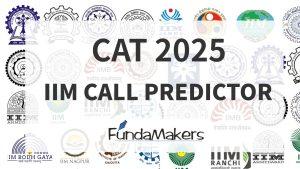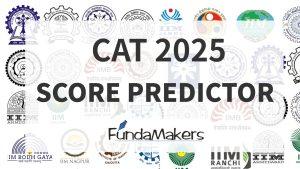If you’re starting your CAT 2025 journey, you might be wondering — “Where do I even begin?”
Well, breathe easy.
In this blog, we’ve :
- broken down the CAT 2025 syllabus section-wise
- added expert tips from FundaMakers mentors,
- and included strategies to smartly approach your prep.
Bookmark this page — it’ll be your cheat sheet for the year.
Understanding the CAT 2025 Exam Structure
CAT consists of three sections:
| Section | Time Limit | Number of Questions | MCQs + TITA | Score Range |
| VARC (Verbal Ability & Reading Comprehension) | 40 mins | 24 | Mix | 0–72 |
| DILR (Data Interpretation & Logical Reasoning) | 40 mins | 20 | Mix | 0–60 |
| QA (Quantitative Ability) | 40 mins | 22 | Mix | 0–66 |
Total Duration: 120 mins
Total Score: 198 (approx.)
TITA: Type In The Answer (non-MCQs)
Section 1: VARC (Verbal Ability & Reading Comprehension)
The VARC section in CAT is all about comprehension, interpretation, and logic—not vocabulary. Your success here depends on how well you understand what you read and how clearly you think while answering under time pressure.
Topic-Wise Breakdown for VARC (CAT 2025 – Expected)
| Topic | Subtopics | Expected No. of Questions | Expected Weightage (%) |
| Reading Comprehension (RC) | Humanities, Philosophy, Science, Economics | 16 | 66% |
| Para Jumbles (TITA) | Logical ordering of jumbled sentences | 2–3 | 10–12% |
| Para Summary | Central idea identification, summarization logic | 2 | 8–9% |
| Odd One Out (TITA) | Theme linkage, irrelevant sentence spotting | 2 | 8–9% |
| TITA Questions (across topics) | VA-based questions without options | 5–6 (including PJ & OOO) | — |
Quick Rundown of Each Topic
- Reading Comprehension (RC):
Most dominant part. Expect 4 long passages—some narrative, others abstract. RCs are designed to test your comprehension under pressure, with questions focused on inference, tone, and author’s intent more than facts.
- Para Jumbles (TITA):
You’ll see 4-5 jumbled sentences. The challenge? No options. You need to sequence them to form a logical paragraph. This tests your grasp of connectors, flow, and thought hierarchy.
- Para Summary:
Small passages followed by four options. You must choose the most accurate and comprehensive summary. The key is identifying what the author intended to say, not just what’s written.
- Odd One Out:
Find the sentence that breaks the logical flow among 4-5 given sentences. Often, all 5 seem relevant at first glance—that’s the trap.
Mentor Tips for VARC
“When you read an RC, don’t get intimidated by complex words. Focus on the relationship between ideas and the author’s tone. Even the toughest passage has breadcrumbs.”
– Karan Gupta (CAT 99%iler in VARC)
“VA questions like para jumbles and odd one out are not just about logic—they’re about confidence. If you’re unsure, mark and move. Don’t let one TITA sink your section.”
– Surya Sir (VARC Strategy Coach)
Section 2: DILR (Data Interpretation & Logical Reasoning)
CAT’s DILR section has become increasingly unpredictable, with sets that blend DI & LR concepts. It’s all about pattern recognition, quick adaptability, and smart selection.
Topic-Wise Breakdown for DILR (CAT 2025 – Expected)
| Topic | Subtopics | Expected No. of Sets | Expected Weightage (%) |
| Data Interpretation (DI) | Tables, Graphs (Bar, Line, Pie), Caselets | 2 | 30–35% |
| Logical Reasoning (LR) | Arrangements, Puzzles, Venn Diagrams, Games & Tournaments | 2–3 | 50–55% |
| Mixed DI + LR Sets | Logic-based data sets, unconventional caselets | 1 | 15–20% |
Quick Rundown of Each Topic
- Data Interpretation (DI):
These sets require data crunching from tables, charts, and graphs. But don’t expect straightforward arithmetic—many sets involve logical assumptions and approximation. - Logical Reasoning (LR):
From linear/circular arrangements to family trees and tournaments—this part tests your ability to build and decode logic chains. Timing is everything. - Mixed Sets (DI + LR):
Some of the toughest CAT sets combine data with constraints, like “X beats Y unless Z is present,” forcing you to analyze and interpret simultaneously.
Mentor Tips for DILR
“Never enter the DILR section with a fixed mindset. Be flexible—your first 5 minutes should go into scanning all sets to pick your best 2-3.”
– Ratnesh Sir (DILR Expert)
“Don’t aim to solve every set. Focus on clarity and confidence in the 2–3 that you pick. DILR rewards the smart, not the greedy.”
– Tushar Nandani (CAT 99%iler in DILR)
Related Blog:
- Section-wise CAT Preparation Tips – VARC, DILR, QA
- How to Prepare for CAT While in College – FundaMakers Mentorship Plan
Section 3: QA (Quantitative Aptitude)
Quant is no longer about learning every formula—it’s about strategy, timing, and choosing the right questions. That’s what separates 90%ilers from 99%ilers.
Topic-Wise Breakdown for QA (CAT 2025 – Expected)
| Topic | Subtopics | Expected No. of Questions | Expected Weightage (%) |
| Arithmetic | Time-Speed, Work, Percentages, Averages, Ratios, Mixtures | 8–10 | 35–40% |
| Algebra | Linear & Quadratic Equations, Inequalities, Functions | 4–5 | 20–25% |
| Number System | Divisibility, Remainders, Base Systems, Factors | 2–3 | 10–12% |
| Geometry & Mensuration | Triangles, Circles, Polygons, Solids | 3–4 | 10–12% |
| Modern Math (Less Frequent) | Logarithms, Set Theory, Probability, Permutation & Combination | 1–2 | 5–8% |
Quick Rundown of Each Topic
- Arithmetic: Forms the core of QA. Most questions seem easy—but some are designed as “speed breakers”. These are deceptively simple but time-consuming.
Example speed-breaker:
“A man travels from A to B at 40 km/hr and returns at 60 km/hr. If the total time is 10 hours, what is the distance between A and B?”
Looks simple? Solving it under pressure eats time—unless you’ve practiced time & work/relative speed strategies.
- Algebra: Abstract but scoring. Keep formulas handy, but focus on pattern identification—especially in inequalities and functions.
- Number System: Usually short but tricky. One concept can lead to multiple traps. Revise LCM, remainders, and cyclicity.
- Geometry: A well-prepared student always solves 1–2 geometry questions quickly. But CAT loves diagram-less or twisted-angle questions.
Mentor Tips for QA
“The best quant students are not the ones who know everything—they’re the ones who skip the right questions.”
– Vishwa Sir (Quant Mentor)
– Rajeev Nathani (CAT 99.82 %iler in QA)
“Don’t waste time on feel-good toughies. If a question feels off in 30 seconds—leave it. Even toppers attempt 16–18 questions, not all 22.”
Mastering the CAT 2025 exam requires a clear understanding of its structure, focused practice on each section, and strategic time management. With consistent effort and smart mock test strategies, you’re all set to ace the exam.
For expert guidance and a structured approach to your preparation, FundaMakers’ resources and mentorship are here to support you every step of the way.
Related Blog:
- Best Mock Test Series for CAT 2025 – FundaMakers Review
- FundaMakers’ Success Stories – Students Who Made It to IIMs



